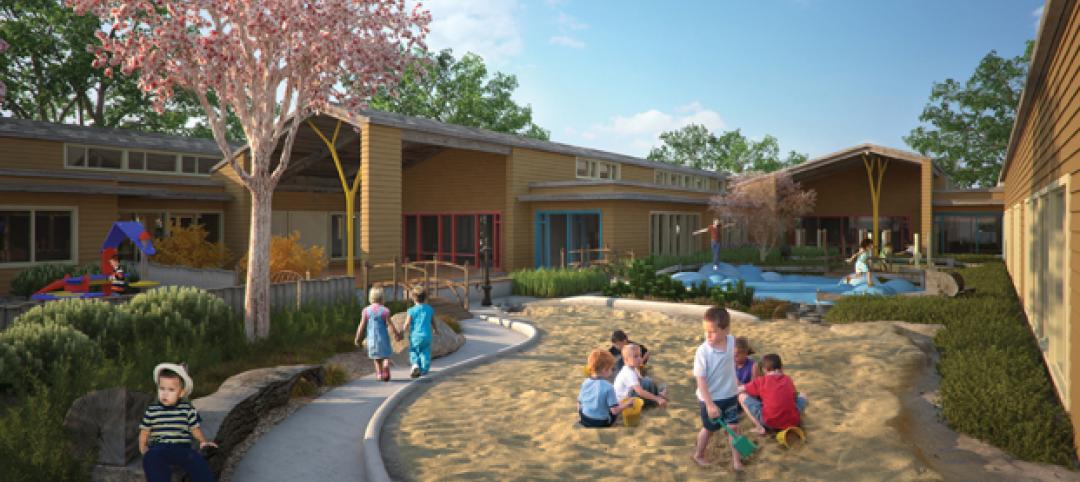The American Institute of Architects (AIA) today announced its “punch list” for Congress that, if completed, will ignite the construction economy by spurring much needed improvements in energy efficiency, infrastructure and resiliency and create jobs for small business
“America needs to create more jobs, to strengthen communities, and find help for millions of young people to succeed in the new economy,” said Robert Ivy, CEO of the American Institute of Architects, "so we've created a punch list—a term that enumerates unfinished items in a construction contract."
“The AIA’s Congressional punch list will help Congress satisfy its implicit contract with the American people to spur growth and create jobs,” Ivy said. “Our legislative agenda reflects the interests of our members, which not so coincidentally reflects the priorities of the American people.”
“America needs to create more jobs, to strengthen communities, and find help for millions of young people to succeed in the new economy,” said Robert Ivy, CEO of the American Institute of Architects. A punch list is a list of actions that need to be taken to satisfy the terms of a contract.
“The AIA’s Congressional punch list will help Congress satisfy its implicit contract with the American people to spur growth and create jobs,” Ivy said. “Our legislative agenda reflects the interests of our members, which not so coincidentally reflects the priorities of the American people.”
The AIA’s Punch List for Congress:
1. Re-enact Expired Energy Efficiency Tax Incentives
Congress left town in December without extending several important tax incentives that expired on New Year’s Day. Of most significance to the design and construction industry is the expiration of a tax break enacted in 2005 for energy efficient commercial buildings. The 179D deduction allowed building owners to claim a tax deduction of $1.80 per sq. ft. of building area to install systems that reduce the total energy and power costs by 50 percent or more when compared with a reference building. As Congress continues to debate long-term tax reform, it can boost the economy and create jobs today by reinstating this deduction.
2. Help Businesses by Reforming Government Procurement Rules
More than 97 percent of architecture firms employ 50 or fewer people; every project they design leads to job opportunities for millions of construction workers. But too many laws and regulations block innovative solutions that maximize the government’s return on its investment. Congress must reform procurement rules so that architects and designers can deliver projects that are safe, productive and sustainable. In 2014, the AIA is aggressively pushing for passage of The Design-Build Efficiency and Jobs Act of 2013 (H.R. 2750), introduced by Rep. Sam Graves (R-MO) in July, which would reform of the design-build contracting process so that more design and architectural firms can bid on federal contracts without fear of losing money in the process.
3. Invest in the Next Generation of Design Leaders
Millions of young people aspire to help their communities build a better future – but a lack of opportunity and the crushing cost of education hold them back. As a result, the design and construction industry faces a severe shortage of talent, at exactly the moment we need to start rebuilding for the future. The AIA urges Congress to pass the proposed National Design Services Act (NDSA), which will give architecture students the relief from crushing student loan debt as that granted young lawyers, doctors and others – in return for pro bono community service.
4. Invest in Infrastructure
Just as the Capitol dome, the symbol of American democracy is undergoing a multi-year renovation, so too must our nation’s infrastructure. Congress should pass a multi-year transportation reauthorization, which would allow for long-term planning that not only repairs roads and bridges but helps communities prosper; and enact a National Infrastructure Bank to finance the design, construction and repair of buildings and other vital infrastructure. Such moves would help free up capital for private sector building projects, and new ways to invest in public sector buildings, providing jobs in the short term and a more competitive economy in the long run.
5. Pass a Common-Sense Energy Efficiency Bill
Last session, the Senate Energy and Natural Resources Committee approved a bipartisan bill, the Energy Savings and Industrial Competitiveness Act of 2013 that would encourage families, businesses and the government to save energy. The Senate should take up the legislation, sponsored by Ohio Republican Rob Portman and New Hampshire Democrat Jeanne Shaheen, in 2014, and oppose efforts by the fossil fuel industry to repeal existing policies that save energy.
6. Help Communities Weather Natural Disasters
Each year, natural disasters kill tens of thousands of people worldwide and inflict billions of dollars in damage. Many parts of the United States are still recovering from tornadoes and hurricanes like Superstorm Sandy. Congress can help communities fortify themselves from such disasters by passing the Safe Building Code Incentive Act, introduced by New Jersey Democratic Senator Robert Menendez and Florida Republican Congressmen Mario Diaz-Balart, which encourages states to voluntarily adopt and enforce nationally recognized model building codes.
About The American Institute of Architects
Founded in 1857, members of the American Institute of Architects consistently work to create more valuable, healthy, secure, and sustainable buildings, neighborhoods, and communities. Through nearly 300 state and local chapters, the AIA advocates for public policies that promote economic vitality and public well being. Members adhere to a code of ethics and conduct to ensure the highest professional standards. The AIA provides members with tools and resources to assist them in their careers and business as well as engaging civic and government leaders, and the public to find solutions to pressing issues facing our communities, institutions, nation and world. Visit www.aia.org.
Related Stories
| Mar 11, 2011
Temporary modular building at Harvard targets sustainability
Anderson Anderson Architecture of San Francisco designed the Harvard Yard childcare facility, a modular building manufactured by Triumph Modular of Littleton, Mass., that was installed at Harvard University. The 5,700-sf facility will remain on the university’s Cambridge, Mass., campus for 18 months while the Harvard Yard Child Care Center and the Oxford Street Daycare Coop are being renovated.
| Mar 11, 2011
Holiday Inn reworked for Downtown Disney Resort
The Orlando, Fla., office of VOA Associates completed a comprehensive interior and exterior renovation of the 14-story Holiday Inn in the Downtown Disney Resort in Lake Buena Vista, Fla. The $25 million project involved rehabbing the hotel’s 332 guest rooms, atrium, swimming pool, restaurant, fitness center, and administrative spaces.
| Mar 11, 2011
Renovation energizes retirement community in Massachusetts
The 12-year-old Edgewood Retirement Community in Andover, Mass., underwent a major 40,000-sf expansion and renovation that added 60 patient care beds in the long-term care unit, a new 17,000-sf, 40-bed cognitive impairment unit, and an 80-seat informal dining bistro.
| Mar 11, 2011
Research facility added to Texas Medical Center
Situated on the Texas Medical Center’s North Campus in Houston, the new Methodist Hospital Research Institute is a 12-story, 440,000-sf facility dedicated to translational research. Designed by New York City-based Kohn Pedersen Fox, with healthcare, science, and technology firm WHR Architects, Houston, the building has open, flexible labs, offices, and amenities for use by 90 principal investigators and 800 post-doc trainees and staff.
| Mar 11, 2011
Blockbuster remodel transforms Omaha video store into a bank
A former Hollywood Video store in Omaha, Neb., was renovated and repurposed as the SAC Federal Credit Union, Ames Branch. Architects at Leo A Daly transformed the outdated 5,000-sf retail space into a modern facility by wrapping the exterior in poplar siding and adding a new glass storefront that floods the interior with natural light.
| Mar 11, 2011
Historic McKim Mead White facility restored at Columbia University
Faculty House, a 1923 McKim Mead White building on Columbia University’s East Campus, could no longer support the school’s needs, so the historic 38,000-sf building was transformed into a modern faculty dining room, graduate student meeting center, and event space for visiting lecturers, large banquets, and alumni organizations.
| Mar 11, 2011
Mixed-income retirement community in Maryland based on holistic care
The Green House Residences at Stadium Place in Waverly, Md., is a five-story, 40,600-sf, mixed-income retirement community based on a holistic continuum of care concept developed by Dr. Bill Thomas. Each of the four residential floors houses a self-contained home for 12 residents that includes 12 bedrooms/baths organized around a common living/social area called the “hearth,” which includes a kitchen, living room with fireplace, and dining area.
| Mar 11, 2011
Oregon childhood center designed at child-friendly scale
Design of the Early Childhood Center at Mt. Hood Community College in Gresham, Ore., focused on a achieving a child-friendly scale and providing outdoor learning environments.
| Mar 11, 2011
Guests can check out hotel’s urban loft design, music selection
MODO, Advaya Hospitality’s affordable new lifestyle hotel brand, will have an urban Bauhaus loft design and target design-, music-, and tech-savvy guest who will have access to thousands of tracks in vinyl, CD, and MP3 formats through a partnership with Downtown Music. Guest can create their own playlists, and each guest room will feature iPod docks and large flat-screen TVs.
| Mar 11, 2011
Construction of helicopter hangars in South Carolina gets off the ground
Construction is under way on a $26 million aviation support facility for South Carolina National Guard helicopters. Hendrick Construction, the project’s Charlotte, N.C.-based GC, is building the 111,000-sf Donaldson Hangar facility on the 30-acre South Carolina Technology & Aviation Center, Greenville.

















